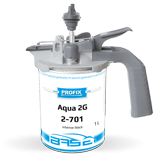Recently added
Most read
Why use the water-soluble lacquers, when the conventional ones are available?
Color digitization
Color digitization
History of the automobile have seen many colors. You don’t know their names, but you have seen them everywhere. Crystal red, deep black, vanilla, canary yellow and that white. It’s whiter than the previous one. Really nice. I think there’s pearl in it. Oh wait. It’s not whiter than the previous one. I don’t know. In quality assurance, color measurement and spectrophotometry are essential in determining a product’s color consistency and accuracy, whether that measurement be in the industrial, textile and automotive industries or in the wide ranging variants of food production, pharmaceuticals, plastics and chemical manufacturing.
The process for quantifying color is complex but also objective and quantifiable, contributing to a future in which precision will be continually perfected, digital workflow will be seamlessly integrated and safe, reliable products will remain priority number one.
What Color Measurement means today and how will it change on near future?
Color measurement today can be depicted as the use of an instrument, like spectrophotometer, to provide an objective description of a color under a standardized set of conditions. These objective descriptions can then be used for quality control — comparing one sample’s color against a target without worrying about the variations in human color perception. Or in other cases, the objective color description is used for the formulation of recipes to reproduce a certain color on a given pigments.
Color measurement is an aspect of quality assurance and quality control used to detect the presence or absence of color, to quantify a product’s color in color space, and to compare a products color to that of a known standard with known evaluation system. Delta E determines difference or distance between two colors.
At present, the most important is to create a database that has the necessary measurements, thanks to which we are able to compare colors with each other. The lower the dE, the closer we are to the goal. It can be assumed that the standard observer notices the color difference as follows:
It is critical that when two pieces of the same color are joined together, they are in color harmony with one another, achieving the esthetic intentions of the designer. If the side mirror or bumper of a car does not match the exterior of the vehicle, these components are considered to be defective and not in color harmony. And here we come to the next topic ...
Why is Color Measurement Important?
Color measurement is an important element to a company’s quality initiatives for several reasons. For some industries, such as food and beverage, color sells product, from the product itself to the packaging that contains the product… It is no different with the automotive industry.
The harmony of colors is one of the main factors affecting the perception of quality by the consumer. As discovered on the basis of research carried out by Seoul International Color Expo in 2004, color and appearance are one of the most important factors in the consumer's decision-making process.
Where is Color Measurement Headed?
Color measurement is heading to a new exciting world which relies on color process automation technologies, that measures very precisely color parameters. Changing the color of a car paint, test sprays and subsequent corrections of the formulas and further tests take a lot of time and may not be very precise. Thanks to the tools provided by the market, process optimization is significant and saves time and money in the long run. Products such as spectrophotometers with the possibility of automatic correction of recipes (eg Profix spectrophotometer), allow us to reduce the working time in a measurable way. The device will never replace the colourist experience, however, the automatic correction of recipes takes place within the existing components of the recipe.
The implemented technologies of automation of color processes in the solutions of Profix color selection systems provide real-time color data using a formulation program and a Cloud application. This gives opportunity to supervise the process: quality and quantity control of components, accurate database search and intuitive spectrophotometer software.
All measurements of lacquer samples are performed in the laboratory using the most modern spectrophotometers that allow the measurement of the reflected or transmitted color of the sample. Measurements on such a device ensure the highest reproduction quality of a similar customer process on other spectrophotometer models. The already mentioned Profix spectrophotometer, which does not require a special cover to close the ambient lighting, provides better features, performance and is more cost-effective than other solutions thanks to the technological progress that allows designing and manufacturing smaller devices and takes up less space on the production line. The benefits include improved performance, reduced operator errors, and reduced quality costs - residual pigments and customer service costs associated with a defective product.
How are Goals Changing?
In the past, the goal of color measurement was narrow in focus, basically that of understanding the color properties of a particular sample or product and its difference when compared to a standard Today, it is about understanding a process so that the process can be improved. The ability to collect data at multiple points throughout a workflow, and share that data within an organization or supply chain where it can be acted on, is critical in helping companies to improve their processes, reduce operating costs, improve efficiencies and improve stakeholder and shareholder value.
Color measurement instruments today that leverage modern technologies like Wi-Fi and Bluetooth for remote data transfer, and that enable seamless integration into a user’s digital workflow environment linking to formulation software. Products that deliver to these needs will continue to be well accepted and lead the way to new and exciting technologies into the future.









